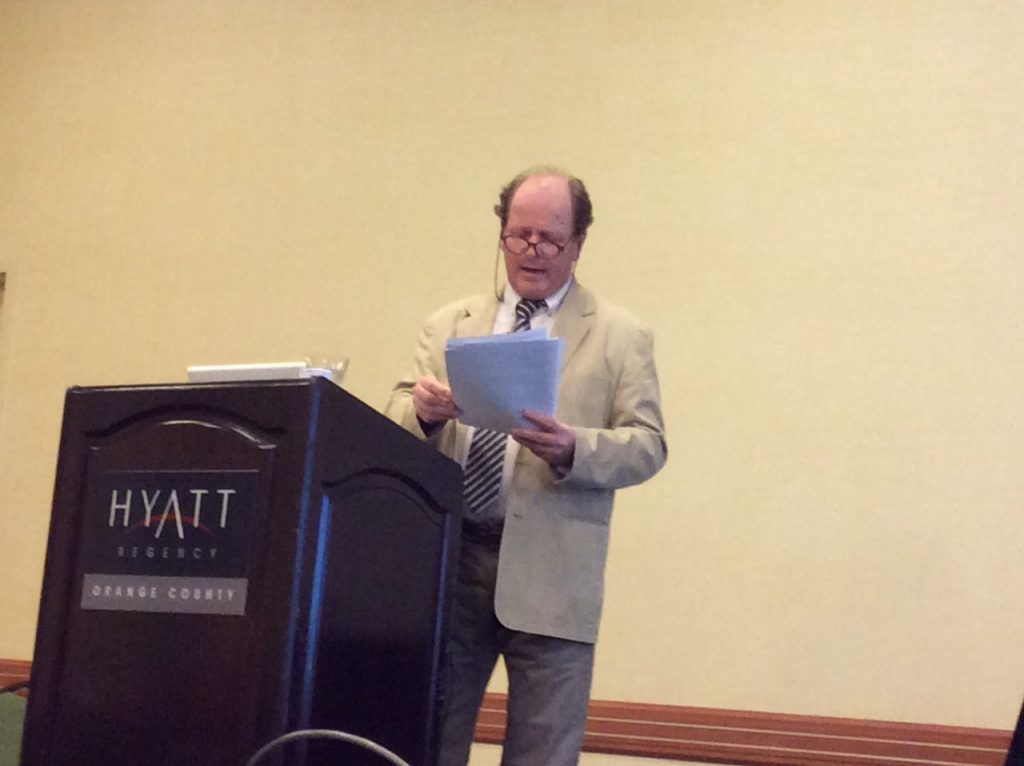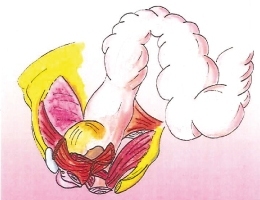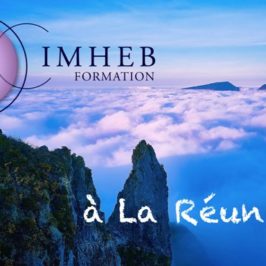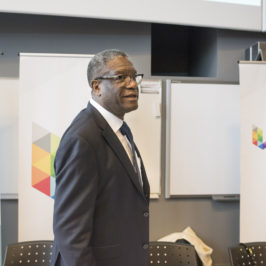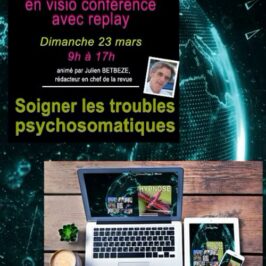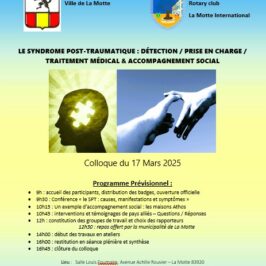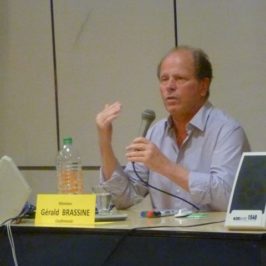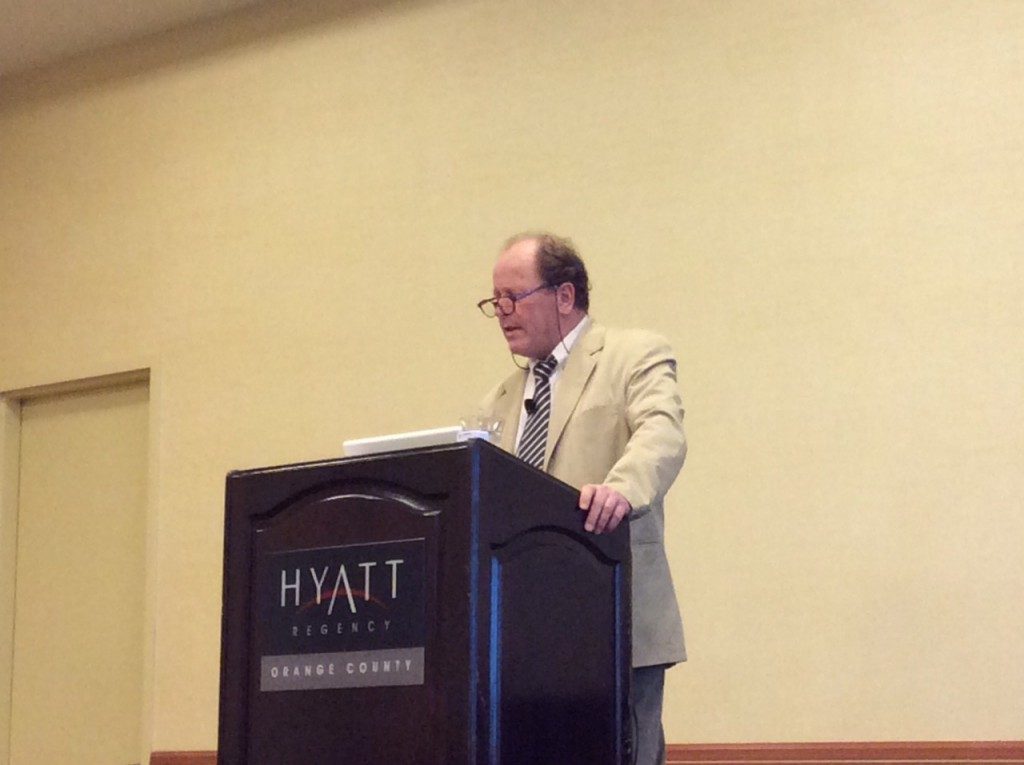 Ce 11 décembre 2014 Gérald Brassine à présenté la
Ce 11 décembre 2014 Gérald Brassine à présenté la
« Trauma Psychotherapy by Reassociation (T.P.R.) »
à Los Angeles, California lors de la
Milton H. Erickson Foundation Conference Treating Anxiety, Depression and Trauma.
Voici le texte de base de la conférence :
THE GOLDEN RULES OF TRAUMA PSYCHOTHERAPY BY REASSOCIATION
Gerald Brassine, psychotherapist. director of M.H.Erickson Institute of Belgium.
Some golden rules which arise from the experience of treating the most serious cases of psychotraumas with interractionnal / conversationnal hypnosis.
In short: Avoidance of secondary victimisation and reliving conversational / interractional hypnosis Zero pain: for this purpose, clearly assumed directivity Radical and systematic Paradoxical use of hypnotic “defenses mechanisms”,considered as: « dissociative protections » Metaphorical co-creation and patient empowerment for the work to ensure a gentle and amusing trance-formation of mental, physical and cognitive memories.
A long experience with cases of sexual abuse, rape, torture survivors and survivors of all kind of horrors compels us to respect a number of obligations, if we want to help people as quickly as possible regain a real quality of life.
It is essential to build a strong therapeutic alliance to be able to work with the most virulent psychological trauma!
Compliance with these requirements provides gentle and effective therapy for the vast majority of cases considered as the most serious : the repeated sexual abuse, rape conducted in the wildest violence, poly-trauma inflicted in childhood, torture, etc.. This clinic of so called polytraumatic cases has enabled the development of appropriate rules. When they are applied in cases of most common trauma (single exposure to an accident, robbery, acts of war, rape, …), they allow a quick resolution of the syndrome. These rules also accelerate the treatment of traumatic life situations such as having experienced childhood years with abusive parents, followed by years of domestic violence, for example.
Such situations deserve the attention of a therapist specializied in traumas, who has a good working knowledge of the use of altered states of consciousness. Indeed, it is imperative to note that, frequently, psychotherapies that employ only verbal expression worsen gradually and sometimes suddenly the state of the person, by involuntary secondary victimization. It usually goes unnoticed because, as we can see, the victims of a post-traumatic stress disorder (PTSD) have become masters in the art of concealing the pain experienced during the recollections. These attempts not to suffer may be voluntary (by conscious efforts not to disclose anything) or unconscious (by occurence of dissociative mechanisms for a reactivated self protection). The increase of psychosomatic pain is just one example of hypnotic protection mechanisms associated with symptoms usually very painful emotionaly.
1 – The first golden rule is probably the most important : it is of the utmost importance to prevent the reviviscence or secondary victimization.
A very common misconception is that you need to relive a traumatic scene. However, the altered state of consciousness involved in any revivification accentuates the symptomatology and the patient’ suffering, preventing cure to happen. Therefore we believe, on the contrary, that the traumatic event and its current resurgence (ie terror, fear, flashbacks, psychosomatic pain, anxiety, nightmares, intrusions: feelings of presence, smells, tastes, etc..) have every reason to be filtered, reprocessed in an almost permanent comfort, guaranteed by the vigilance of the hypnotherapist. This conceptualization implies that any painful revivification should ideally be excluded or immediately transformed ! This avoidance rule of the reviviscence is essential for a full desensitization of even all forgotten memories . This article offers several practical ways to achieve it.
2 – The second rule is the concept of « Conversational Hypnosis »
During the training courses I took in Ericksonian hypnosis starting in 1980 (including during the year 1983-84, when studying in MRI in Palo Alto, USA, Arizona), I received that kind of widespread training : Ericksonian teaching heavily influenced by classical hypnosis. I have myself been teaching it in the Erickson Institute in Belgium of which I am the initiator (1984), as well as in IMENF for many years. It was in 1985 that I had the pleasure to meet Kay Thompson (friend, student and collaborator of M.Erickson for thirty years) at a conference in Rome. To my great surprise, while we were on the stairs outside the lecture hall and I was asking her some questions about hypnosis, I ended up in a trance state. She induced it without artifice, without induction or « Hypnotist tone of voice ». This real shock revealed to me what my training had not taught me …and it gave me the urge to also achieve it. This type of hypnosis immediately reminded me of the Erickson’s audio and videotapes. Should this type of hypnosis be called « active hypnosis »? Standing on the steps, I realized that I was in an altered state of consciousness that allowed me to ask questions and to acknowledge her answers while being in that different state. I could think with the specific understanding and capacities that an altered state of consciousness can provide. Subsequently, Kay Thompson, very generously invited me at her home in Pittsburgh. There, I got familiar with « going into standing hypnosis », in action and while speaking. It was possible for me to peel potatoes or push a shopping cart in a supermarket, while discussing with her about hypnosis, psychotherapy and groceries.
I had later the opportunity to meet a contemporary and friend of M.Erickson who also established this type of active hypnotic relationship, participative and conversational.
How to describe this type of hypnosis?
– This hypnosis is active, similar to the one described by M.H.Erickson as constitutive of deep hypnosis. It is active in the sense that the patient remains active throughout the whole procedure in which he is involved. He learns and realizes that he can control his autonomic nervous system.
– It is conversational because the hypnotherapist invites and teaches the patient to speak, to describe his condition, to try some of the proposals that aim to make him correct, control or regain control over his emotions, over his sensations (of anxiety, psychosomatic pain, etc.).
– It is « participative » in the sense that it is the patient who tries the proposals offered by the hypnotherapist and is encouraged to use his own ideas to master and control his symptoms and old content, even painful ones.
Therefore, the patient is asked to speak at all times (which also deepens the trance): a usual conversation is established between patient and therapist.
It is therefore important to agree on the language used about conversational hypnosis.
Over the past twenty years, the notion of conversational hypnosis has slipped into a definition where the hypnosis is done without announcing it or declaring it, the patient being surprised into hypnosis. This type of hypnosis is often described as the result of a monologue (and sometimes even a soliloquy) of the hypnotherapist through the use of metaphors or via the « Hypnotist sleepy tone of voice » from classic hypnosis. Some go much further by talking about hypnosis « without hypnosis ». The nonsense of this seems to go unnoticed by many. Could this change in the meaning of « conversational” be attributed to Milton Erickson’s famous case : « the man with tomato plant induction »?
Indeed, in this story, Erickson is dragged to the bedside of a cancer patient with severe pain, by his family. Anesthetics (antalgic) used are no longer effective and the patient displays hostility against psychologists and refuses such assistance. Forced by the context requirements, Erickson presents himself as a family friend and discusses with him the growth of a tomato plant (the man is a gardener). Indirectly and without an explicit declaration of hypnosis, he uses this technique called « interpersal technique ».
This example was transcribed in many books about Erickson. However It seems that only in one or two similar cases, Erickson found himself in the same kind of situation where he had to deviate from his usual ethical principle: ask the person to be active and therefore voluntarily involved in the hypnotic process. In most cases, Erickson exchanges with a patient actively involved in the development of hypnotic phenomena and consciously aware of the hypnotic situation in which he finds himself. Milton Erickson invites the person to see the process and the hypnotic phenomena, to marvel at it and to seize it for his own benefit.
In this sense, we are far from a conversational hypnosis in which only the hypnotherapist expresses himself, in which the patient is asked to be passive! Indeed, deep (somnambulistic) hypnosis in psychotherapy is certainly not: being close to sleep, characterized by apathy and a lack of response. Deep hypnosis, as defined by M. Erickson, is an active state in which the patient can do whatever he would do in the usual state of consciousness and this by respecting his smallest needs. Therefore the conversational mode requires, however, explicitly asked effort from the patient (in and out of the altered state of consciousness) to talk, to communicate, to oppose or to agree with the proposals made by the operator.
The conversational mode is by no means a situation of manipulation in which, while talking, the inductor tries to create a hypnotic state, without a clear declaration of hypnosis. It is rather the opposite! Here, nothing is done without his knowledge. Instead collaboration is established between patient and therapist. This aspect of hypnosis is very clearly defined in the same way by Kay Thompson in her writings.
This accepted shortening of the term “conversational” could be attributed to a youthful error of a particular Ericksonian movement.
3 – From the first two points, follows the applicability and respect of what we will call: the golden rule « no pain »
This rule leads to the ability to work effectively, on one hand, and amazingly fast, on the other hand, to solve extremely difficult or painful memories and their current symptomatic corollaries, in a situation of non-pain and preferably even fun!
Therefore, « guidance of the patient at the same time friendly and firm (protective, to avoid the risk of reliving) » should be realized in an altered state of consciousness constantly conversational, so the therapist is at all times informed of the progress patient is doing on « sensitive plates of his traumatic memories » and that in a state of maximum comfort. Even more effective are the moments of fun and pleasure during which the patient is actively involved in this double transformation procedure of traumatic incidents and memories.
Constant back and forth to the starting comfort position (long prepared and hypnotically developed with the patient in advance) will allow for healing if comfort is eroded during desensitization. This serves as training and learning situation for different hypnotic phenomena to reprocess past and still present pains (including current somatic pain).
The therapist’s directivity and creativity are essential in the phases of gradual desensitization. For example, one of the elements of the traumatic event, however small, can be brought separately in the place of safety (for example, only the perpetrator’s knife will be brought on the beach of the favorite vacation spot, among beach towels, among other guests, etc.).
Gradually, other elements of the memory will be brought to this place; then the attacker previously reduced and ridiculously dressed-up (as garden gnome, for example) will eventually be brought to the beach as well. The patient has been previously invited to numb and dissociate himself from the scene, for example looking at the beach from a flying carpet from which he will have a plunging view from a distance.
All available creative ways and hypnotic skills will be involved at all times, to bring a permanent comfort during the process. The best this rule is respected, the more the work will be done quickly.
4 – Use of paradoxical « Dissociative Protections »
For David Cheek, the altered state of consciousness that occurs at the moment of the traumatic incident is probably the cause of the wide variety of PTSD symptoms and the hypnotic component thereof. Amnesia, various dissociations, anesthesia, depersonalizations, psychosomatic conversions are there to testify.
We propose that these symptoms be used, paradoxically developed to better overcome them and to desensitize the content and memories they serve to protect. David Cheek said that if a hypnotic state is the cause of the trauma, then later an altered state of consciousness is required to eradicate the symptoms that are listed on this specific level of consciousness. Hypnotherapists can only agree with this view.
A lot of authors express the fact that the traumatic incident activates a freezing mechanism which long extends beyond the time of the initiating trauma. Emotions, sensations and cognitions are fixed and remain intense; they are expressed in the usual symptoms of PTSD sufferers. The therapist’s job is to de-freeze gently and hypnotically desensitize these phenomena captured in the patients’ heart.
The traumatized person is an expert in the use of hypnotic / dissociative defense mechanisms that I like, for better understanding, to rename “Dissociative Protections”. Even if these are only “poor crafts quality or Do-it-yourself job” of the unconscious, they have protected the person somehow so that she may survive and will continue to do so as long as the traumatic pain fire has not been extinguished. However, these protections have their setback since living anesthetized, dissociated and enduring psychosomatic illnesses is nothing enviable… And we do not forget amnesia that protects the pain of memory, which some novice therapists still think is better not to touch: any amnesia is the hidden face of serious symptoms including psychosomatic diseases which are just one example of dissociated occurrence. However, if the therapist ensures constant patient comfort during the procedure of desensitization of the trauma, removing the amnesia will be painless and will eliminate the associated symptoms.
This fourth point is one of the most important innovations of Trauma Psychotherapy by Reassociation (TPR) that we designed in the light of the golden rules described in this article. The most useful concept from which are declined different techniques to ensure comfort and safety of the patient, is to use, develop and amplify the spontaneous (or not) hypnotic phenomena, which originated at the time of traumatic incident, to better revisit and safely correct active traumatic injuries and current pain. The utilized symptom or hypnotic phenomenon carrier of the symptom will also disappear as a protective device. Example: the raped person will no more dissociate, or being numb, or suffer from psychosomatic pain whenever in the arms of the loved and chosen ones.
5 – Finally, the Metaphorical Co-Creation for a Gentle Trance-formation of Mental and Physical Memories refers to the use of appropriate means to ensure this important comfort.
Our technique, developed since the early 2000s, is to use and amplify the spontaneous (or not) hypnotic phenomena, which had their origin at the time of the traumatic incident, to better revisit and safely correct active traumatic injuries. The idea is to use all available metaphorical tools, all filters, distances and transformations made, performed through dissociative protections which, intertwined with the points and concepts outlined above.
They reflect the fun and creative aspects used by a patient fully aware of the importance of personal involvement. This co-creation will make this flying-high therapy like child’s play in which patient and therapist will have fun together!
6. Conclusions
Bibliography
Erickson, MH (1999): « The collected papers of Milton H. Erickson on Hypnosis (Vol. I) « The nature of hypnosis and suggestion”
Thompson, K. (1979): « The case against relaxation » In G.Burrows, DRCollison and L.Dennerstein Editions. Hypnosis, p. 41-5
Brassine, G. (2008): « Preventing, detect and manage the sexual abuse suffered by children » (« Prévenir, détecter et gérer les abus sexuels subis par les enfants » in Dangles, Toulouse – France)




